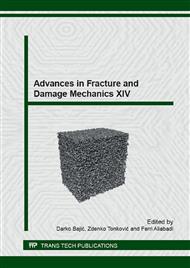p.149
p.153
p.157
p.161
p.165
p.169
p.173
p.177
p.181
A Simulation Study of Surface Breaking Crack in Concrete Beam Based on Time-Reversed Theory of Surface Wave
Abstract:
Existing non-destructive test methods are usually ineffective in detection of surface breaking cracks with large depths in concrete structure. This paper introduces a method suitable for detection of deep cracks based on surface wave time reversal theory. A numerical simulation based on the finite element model is performed to investigate surface cracks detection. A damage index was defined based on the correlation coefficient between the actuated and the reconstructed wave signals. The results demonstrated that the presence of crack had a significant influence on the propagation characteristics of surface waves along concrete. Cracks in different sizes were introduced and correlated with the damage index. Enlarging the crack depth resulted in an increase in the distortion of reconstructed signals, and a higher damage index was obtained. The results illustrated the effectiveness of the surface wave time-reversal process in identifying cracks in concrete structures.
Info:
Periodical:
Pages:
165-168
Citation:
Online since:
September 2015
Authors:
Keywords:
Price:
Сopyright:
© 2016 Trans Tech Publications Ltd. All Rights Reserved
Share:
Citation:


